Home
About Us
Booking Info
Travel forms
Custom Programs
FAQ
Country info
Volunteer
Client Comments
Weather
Insurance
Global Community
Service Foundation
Itinerary search
Order a Catalog!
Register Now

Or call:
1.800.419.4446
Email us
|
 |
Ba Be Lakes National Park, a national park established in 1992 and is centered on the beautiful Ba Be Lake. The lake is surrounded by limestone hills carpeted in tropical evergreen forest. The park contains a very high diversity of flora, fauna, Tay and Dao ethnic minorities. This less developed area invites the more intrepid traveler.
Bac Ha, located east of Sa Pa, has emerged as an alternative to Sa Pa for the more adventurous. It offers visitors a more authentic experience in exploring remote ethnic minority villages.
Buon Ma Thout, the capital of Dak Lak Province. A large percentage of the area’s population is made up of ethnic minorities. One of the region’s main crops is coffee. This area is known for elephant riding and hill tribe villages.
Can Tho, the capital of Can Tho Province, is the political, economic, cultural and transportation center of the Mekong Delta. This bustling city is connected to popular centers in the Delta by a system of rivers and canals.
|
Chau Doc, which lies along the bank of the Hau Giang River, is a commercial center not far from the Cambodian border. Chau Doc has many Chinese, Cham and Khmer communities.
Cao Dai Temple of Tay Ninh, the birthplace of the Cao Dai religion. This religion draws its origins from Christanity, Buddhism, Taoism, Hinduism and Islam. Included amongst the many gods are Joan of Arc, Sun Yat Sen, William Shakespeare and Victor Hugo. Colorful followers worshiping the “all-seeing eye” can be observed at noon inside of the cathedral.
Cat Ba, Ha Long Bay’s largest island, boasts the country’s first national park with numerous lakes, limestone grottoes, swamps, caves, and pristine beaches. Its tranquil waters and hidden caves are ideal for exploring by kayak or in small boats.
Cuc Phuong National Park, located 99 miles south of Ha Noi, is a lush tropical forest with a variety of indigenous wildlife, including the spotted deer and yellow macaque.
|
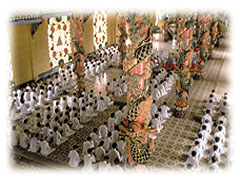 |
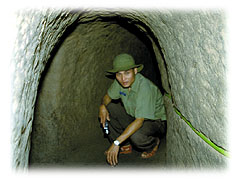 |
Cu Chi Tunnels, an “underground village” that was built over a period of 25 years beginning in the late 1940’s. Located 25 miles northwest of Ho Chi Minh City, the Cu Chi Tunnels is a labyrinth of over 124 miles of underground tunnels. During the war they were home to over 10,000 troops. Areas shown to the public include underground layouts for hospitals, kitchens, and sleeping quarters.
Da Lat, the “City of Eternal Spring,” is renowned for its valleys, lakes, waterfalls, flower gardens, university, and over 2,000 French-designed buildings and villas. The surrounding mountainous hillside is ideal for hiking and visiting the villages of the indigenous Lat people.
Da Nang, Viet Nam’s fourth largest city, is the former capital of the Kingdom of Champa and the port of entry for the first American military landing in 1965. The coastline of Da Nang is endowed with a varied landscape including Marble Mountain and China Beach.
|
Dien Bien Phu, located approximately 10 miles from the Laos border and 248 miles west of Ha Noi, is most famous for the resistance battle against the French in 1954, which led to the end of French colonial rule. Today, this remote area attracts a variety of visitors who are interested in history, culture and adventure. Numerous ethnic hill tribe groups, including the Thai, H’mong, Meo and Dao, reside in the area for those interested in the cultural aspect of the visit.
DMZ (Demilitarized Zone), an area that partitioned North and South Viet Nam from 1954 to 1975 at the 17th parallel. Famous for its battlefields, the northernmost area of former South Viet Nam of the American–Viet Nam war.
Hai Phong, Viet Nam’s third most populous city, is the north’s main industrial center and one of the country’s most important seaports. Hai Phong City today is one of the most popular gateways to the World Heritage Site of Ha Long Bay.
|
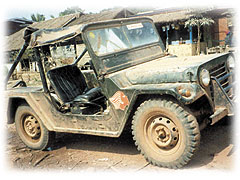 |
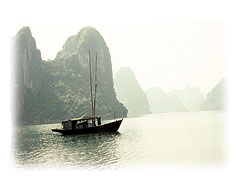 |
Hanoi, the capital of Viet Nam, has traditional small– town charm that contrasts with bustling Ho Chi Minh City. Despite urbanization, Hanoi has preserved the architectural legacies of its French colonial era and has maintained the parks and lakes that are scattered throughout the city. Sights to see include: Old Quarter; Lake of the Restored Sword, Temple of Literature, One Pillar Pagoda, Ho Chi Minh Mausoleum, Ethnology Museum, Fine Arts Museum, and numerous pagodas and temples. Hanoi, is a starting point for Viet Nam tours outside the city including excursions to handicraft villages in Bac Ninh province, the Perfume Pagoda, Mai Chau, Ha Long Bay, Cat Ba Island, Cuc Phuong National Park, Hoa Lu, Sa Pa, and Bac Ha.
Ha Long Bay, a World Heritage Site, is one of Viet Nam’s most spectacular and romantic locales. This natural wonder features over 1,600 limestone peaks that soar from the Gulf of Tonkin and numerous grottoes and caves that depict legendary Vietnamese folktales. Its tranquil waters and hidden caves are ideal for exploring by kayak or in small boats. |
Ho Chi Minh City (HCMC), still commonly referred to as “Saigon,” is a bustling metropolis with over 5 million people and the largest city in Viet Nam. HCMC is the most modern city in the country, defined by a host of luxury hotels, high-rise office and apartment buildings; an array of international restaurants and cafes; and intense nightlife. Sights to see: the grounds of the former US Embassy, Reunification Hall, Cho Lon (Chinatown), Old Post Office, Notre Dame Cathedral, History Museum, Ben Thanh market, and numerous pagodas and temples. Excursions outside of Saigon include Tay Ninh, Cu Chi Tunnels, Vung Tau, Long Hai, Phan Thiet and the Mekong Delta.
Hoi An, a former commercial port located 19 miles from Da Nang, was a thriving international trading port from the 16th to 18th centuries, visited by the Portuguese, Japanese, Chinese, Dutch, British and French. Fortunate to escape damage from the Vietnamese–American war, this picturesque fishing village today retains the feel of centuries past with its eclectic pastel-hued buildings and narrow winding streets lined with antique stores, tailor shops and galleries.
|
 |
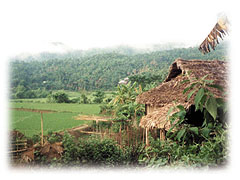 |
Hue, the former royal capital and cultural, religious and education center of the country during the 19th and 20th centuries. Today, the city retains relics of its regal past, as apparent in the Thien Mu Pagoda, Royal Tombs, and the Citadel in the Forbidden City, a World Heritage Site. Hue’s shady boulevards and pleasant atmosphere create an ideal environment for leisurely cycling and walking.
Mai Chau, situated in the mountainous region southwest of Hanoi, is home to Viet Nam’s most beautiful textiles and numerous ethnic hill tribes, particularly the H’mong, Thai and Dao. Activities include hiking through the highlands, visiting hill tribe villages and overnighting in traditional longhouses.
Mekong Delta, the “rice bowl” of Viet Nam and the deposit point of the Mekong River that flows southward from distant Tibet. The lush landscape, with its checkered rice paddies and winding rivers, is the heart of rural Viet Nam. Its abundant fruits and vegetables are evident in the colorful floating and land markets.
|
The Delta also has a diverse mix of people of Khmer and Chinese descent with the Khmer influence most visible near the Cambodian border. Destinations to visit in the Delta include Vinh Long for its land market and Cai Be for its floating market, Soc Trang and Tra Vinh for their Khmer pagodas, Chau Doc for its silk-making and Can Tho – the political, economic, cultural and transportation center of the Mekong Delta.
Mt. Fansipan, at a height of 10,338 feet, is Viet Nam’s highest peak. The summit towers above Sa Pa located 6 miles away.
My Son, located 44 miles from Da Nang, the center of the Kingdom of Champa and the site of Viet Nam’s most important Cham ruins. Many of the Cham relics housed in Da Nang’s Cham Museum were collected from My Son.
Nha Trang, best known for its picturesque coastline and wide shady French boulevards dotted with sidewalk cafes. Delicious seafood, beautiful wide beaches and sparkling emerald waters make it a popular resort destination.
|
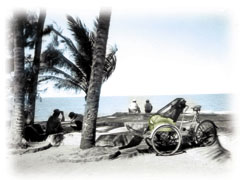 |
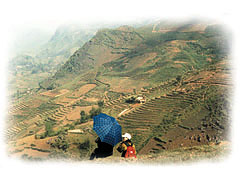 |
Phan Thiet, a small seaside town located midway between Ho Chi Minh City and Nha Trang. It is home to numerous beach resorts and the Ocean Dunes’ 18-hole links golf course.
Phu Quoc, located in the Gulf of Thailand, is Viet Nam’s largest island and is famous for its “nuoc mam” or fish sauce. Its secluded white sand beaches lined with coconut trees remain an undiscovered paradise.
Pleiku and Kontum, located in the Central Highlands, a remote and complex area where a serene lifestyle exists in spite of an impoverished environment. The area is predominately inhabited by ethnic hill tribes, specifically the Jarai, Banhar, and Sedang, who still practice age-old traditions. This area is ideal for hiking, elephant riding, and exploring hill tribe villages.
Sa Pa, located approximately 248 miles north of Ha Noi near the Chinese border, is famous for its numerous ethnic hill tribes and Mt. Fansipan, Viet Nam’s highest peak. Situated at 5,264 feet above sea level, Sa Pa’s cool climate makes it ideal for hiking among its rolling hills and mountains.
|
|
|

© From 1998 Global
Spectrum, Inc. - Travel Specialists to Viet Nam and
Beyond
Email Global Spectrum Travel
/ 1.800.419.4446
3907 Laro Court, Fairfax, VA 22031 USA |
|



